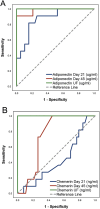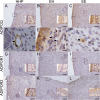Adipokines as biomarkers of postpartum subclinical endometritis in dairy cows
- PMID: 32567551
- PMCID: PMC7424352
- DOI: 10.1530/REP-20-0183
Adipokines as biomarkers of postpartum subclinical endometritis in dairy cows
Abstract
Adipokines emerged as regulators of metabolism and inflammation in several scenarios. This study evaluated the relationship between adipokines (adiponectin, chemerin and visfatin) and cytological (subclinical) endometritis, by comparing healthy (without), transient (recovered by 45 days postpartum (DPP)) and persistent (until 45 DPP) endometritis cows (n = 49). Cows with persistent endometritis had higher adiponectin concentrations in plasma (at 21 DPP, P < 0.05 and at 45 DPP, P < 0.01) and in uterine fluid (at 45 DPP, P < 0.001), and higher chemerin concentrations in plasma (P < 0.05) and uterine fluid (P < 0.01) at 45 DPP than healthy cows. Cows with persistent endometritis had higher gene transcription in the cellular pellet of uterine fluid and protein expression in the endometrium of these adipokines and their receptors than healthy cows. Adiponectin plasma concentrations allowed to discriminate healthy from persistent endometritis cows, in 87% (21 DPP) and 98% (45 DPP) of cases, and adiponectin and chemerin uterine fluid concentrations at 45 DPP allowed for this discrimination in 100% of cases. Cows with concentrations above the cutoff were a minimum of 3.5 (plasma 21 DPP), 20.4 (plasma 45 DPP), and 33.3 (uterine fluid 45 DPP) times more at risk of evidencing persistent endometritis at 45 DPP than cows with concentrations below the cutoff. Overall, results indicate a relationship between adipokine signalling and the inflammatory status of the postpartum uterus of dairy cows, evidencing that adipokines represent suitable biomarkers of subclinical endometritis, able to predict the risk of persistence of inflammation.
Conflict of interest statement
Joëlle Dupont is on the editorial board of
Figures






Similar articles
-
Inflammatory cytokines and acute-phase proteins concentrations in the peripheral blood and uterus of cows that developed endometritis during early postpartum.Theriogenology. 2015 Jul 1;84(1):11-8. doi: 10.1016/j.theriogenology.2015.02.006. Epub 2015 Feb 12. Theriogenology. 2015. PMID: 25765299
-
Associations among serum pro- and anti-inflammatory cytokines, metabolic mediators, body condition, and uterine disease in postpartum dairy cows.Reprod Biol Endocrinol. 2013 Nov 9;11:103. doi: 10.1186/1477-7827-11-103. Reprod Biol Endocrinol. 2013. PMID: 24209779 Free PMC article.
-
Profiling inflammatory biomarkers in cervico-vaginal mucus (CVM) postpartum: Potential early indicators of bovine clinical endometritis?Theriogenology. 2017 Nov;103:117-122. doi: 10.1016/j.theriogenology.2017.07.039. Epub 2017 Jul 29. Theriogenology. 2017. PMID: 28780482
-
Genesis of clinical and subclinical endometritis in dairy cows.Reproduction. 2023 Jun 28;166(2):R15-R24. doi: 10.1530/REP-22-0452. Print 2023 Aug 1. Reproduction. 2023. PMID: 37294111 Review.
-
Rationale for treatment of endometritis in the dairy cow.Vet Clin North Am Food Anim Pract. 1987 Nov;3(3):593-607. doi: 10.1016/s0749-0720(15)31132-4. Vet Clin North Am Food Anim Pract. 1987. PMID: 3319086 Review.
Cited by
-
Effects of seasonal chronic heat stress on body thermoregulation, cortisol release and uterine health in postpartum native Alentejana and Mertolenga beef cattle.BMC Vet Res. 2025 Jun 5;21(1):404. doi: 10.1186/s12917-025-04810-z. BMC Vet Res. 2025. PMID: 40474271 Free PMC article.
-
Is the IL1RA/IL1B Ratio a Suitable Biomarker for Subclinical Endometritis in Dairy Cows?Animals (Basel). 2022 Nov 30;12(23):3363. doi: 10.3390/ani12233363. Animals (Basel). 2022. PMID: 36496884 Free PMC article.
-
Expression of Locally Produced Adipokines and Their Receptors during Different Physiological and Reproductive Stages in the Bovine Corpus Luteum.Animals (Basel). 2023 May 27;13(11):1782. doi: 10.3390/ani13111782. Animals (Basel). 2023. PMID: 37889693 Free PMC article.
-
Transcriptomic Establishment of Pig Macrophage Polarization Signatures.Curr Issues Mol Biol. 2023 Mar 12;45(3):2338-2350. doi: 10.3390/cimb45030151. Curr Issues Mol Biol. 2023. PMID: 36975521 Free PMC article.
-
Chemerin is secreted by the chicken oviduct, accumulates in egg albumen and could promote embryo development.Sci Rep. 2022 May 29;12(1):8989. doi: 10.1038/s41598-022-12961-4. Sci Rep. 2022. PMID: 35644891 Free PMC article.
References
-
- Astessiano AL, Carriquiry M, Mattiauda DA, Adrien ML, Chilibroste P, Meikle A. 2017. Endometrial gene expression in primiparous dairy cows at the end of the voluntary waiting period is affected by nutrition: total mixed ration vs increasing levels of herbage allowance. Reproduction in Domestic Animals 52 798–805. (10.1111/rda.12981) - DOI - PubMed
-
- Barbe A, Bongrani A, Mellouk N, Estienne A, Kurowska P, Grandhaye J, Elfassy Y, Levy R, Rak A, Froment P. et al. 2019. Mechanisms of adiponectin action in fertility: an overview from gametogenesis to gestation in humans and animal models in normal and pathological conditions. International Journal of Molecular Sciences 20 1526. (10.3390/ijms20071526) - DOI - PMC - PubMed
-
- Bongrani A, Mellouk N, Rame C, Cornuau M, Guérif F, Froment P, Dupont J. 2019. Ovarian expression of adipokines in polycystic ovary syndrome: a role for chemerin, omentin, and apelin in follicular growth arrest and ovulatory dysfunction? International Journal of Molecular Sciences 20 3778. (10.3390/ijms20153778) - DOI - PMC - PubMed
MeSH terms
Substances
LinkOut - more resources
Full Text Sources
Medical

